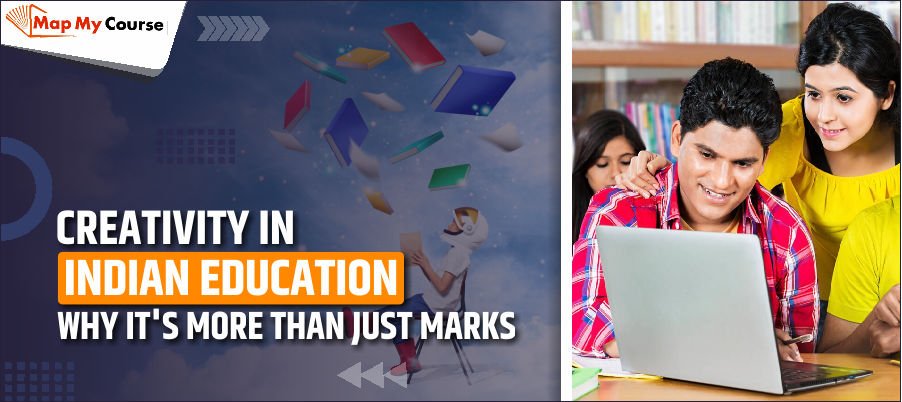In India, most people believe that education is primarily about achieving good grades. From school exams to board results, students are always under pressure to achieve high scores. But is that really what learning is all about?
The truth is, education should also help students think in new ways, express their ideas, and be creative. That’s why creative education in India is becoming more important now than ever before. It’s not just about reading books and writing exams—it’s also about learning through art, music, drama, and fun activities.
The NEP 2020 (New Education Policy) is helping bring these changes. With NEP 2020 creativity, students are getting more chances to explore their talents, learn new skills, and enjoy learning. Schools are starting to include creative subjects and give more value to things like drawing, singing, acting, and innovation.
In this blog, we’ll talk about why creativity matters in education, how it’s changing the way students learn, and how you can balance marks and creativity together.
What Is Creative Education?
Creative education means learning in a way that helps students use their imagination and think in new ways. It’s not just about learning from books or memorizing answers. Instead, it helps students to ask questions, find different solutions, and try new ideas.
This type of learning gives students the freedom to be creative, take small risks, and think on their own. It’s okay to make mistakes, because that’s how you learn better.
Creative education includes fun and useful subjects like art, music, dance, drama, drawing, designing, and even using technology. These subjects help students become more confident, solve problems, and express their thoughts clearly.
The Importance Of Creativity in Indian Education
Creativity is not just about painting, music, or acting. It’s about thinking in new ways, solving problems, and expressing your own ideas. Here’s why it’s important for students in India:
- Improves Problem-Solving Skills
When students think creatively, they learn to look at problems from different angles. This helps them find smart, new ways to solve issues, whether it’s a school project or a real-life challenge.
- Boosts Critical Thinking
Creative tasks like writing stories, designing models, or performing in plays help encourage students think deeply and make connections. This builds strong critical thinking skills, which are useful in every subject.
- Encourages Self-Expression
Creativity allows students to share their thoughts, feelings, and ideas in their own way. Whether it’s through art, music, or writing, it builds self-confidence and emotional strength.
- Makes Learning More Fun and Meaningful
Let’s be honest, learning through only books can get boring. Creative activities make lessons more interesting. They help students enjoy what they’re learning and remember it better.
- Supports All-Round Development
It’s not just about marks. Creative education helps in emotional, social, and intellectual development. It builds personality and helps students become well-rounded individuals.
- Builds Communication and Teamwork
When students work on group projects, perform together, or share ideas, they learn to communicate clearly and work as a team. These are important life skills needed in every career.
- Reduces Stress and Exam Pressure
When students get a chance to explore creativity, they feel less stressed. It creates a balance between studies and personal growth, making school life more enjoyable.
The Impact of Creativity on Education
When creativity is added to learning, it makes a big difference. It helps students not just study for marks, but also enjoy learning, think better, and grow as people. Let’s see how:
- From Passive to Active Learning
In traditional learning, students only listen and learn by heart. But with creativity, students do more—they ask questions, do activities, work in groups, and learn by doing. This helps them understand things better.
- Connecting Different Subjects
Creative learning helps students see how different subjects are connected. Like in a science project, you may need some drawing, writing, and even maths. This is useful because real-life problems don’t come from just one subject.
- Building a Growth Mindset
Creativity teaches students that it’s okay to make mistakes. What matters is to try again. This builds a positive mindset where students believe they can get better by working hard.
- Respecting Different Opinions
In creative classrooms, students share ideas and listen to others. This helps them respect different opinions and learn to work in a team.
- Bringing Joy and Curiosity into Learning
Creative learning makes school more fun and interesting. With music, art, role play, or hands-on projects, students become more curious and excited about learning.
- Making Students Think Independently
Instead of only following the book, students learn to think for themselves. They ask “why” and “how,” and come up with their own ideas.
Creative Subjects Gaining Recognition in Indian Schools
For a long time, school education in India focused only on subjects like Maths, Science, and English. But now, thanks to changes like NEP 2020, schools are slowly starting to value creative subjects too.
Here are some creative subjects that are finally getting the attention they deserve:
- Art and Design
Drawing, painting, and designing these subjects that help students express themselves and improve their imagination. Many schools now have proper art classes and even art competitions.
- Music and Dance
Music and dance are not just hobbies anymore. Schools are including them as part of the timetable. These subjects help students relax, feel confident, and learn rhythm and coordination.
- Drama and Theatre
Acting helps students build confidence, speak clearly, and understand emotions. School plays and drama clubs are becoming popular and are a great way to improve communication skills.
- Innovation and STEM Activities
Some schools are encouraging students to build models, work on simple science projects, or use technology in a fun way. STEM (Science, Technology, Engineering, Math) clubs are giving students space to be creative and think like inventors.
- Craft and DIY Projects
Subjects like craft and life skills are making a comeback. Making things with your hands helps students learn patience, focus, and creativity.
- Storytelling, Poetry & Creative Writing
More schools now give time for writing stories, poems, or even comic strips. This helps students play with language, build vocabulary, and develop their own voice.
How Students Can Balance Marks and Creativity
- Manage Your Time Well
Set a fixed time for studies and a little time for creative hobbies. Even 30 minutes a day for your interest—drawing, dancing, or coding—can make a big difference.
- Use Creative Methods to Study
Make diagrams, mind maps, flowcharts, or draw quick doodles to remember things. Learning becomes easier and more fun when you add your own touch.
- Join School Clubs or Online Communities
Most schools have clubs like music, art, drama, coding, or writing. Join the one that excites you. If your school doesn’t have one, look for online platforms where students share creative work.
- Link Creativity to Academics
Try using your creativity in school projects or presentations. For example, if you have to give a science presentation, make a cool model or use storytelling to explain the topic.
- Don’t Be Afraid of Marks
Marks are important, yes, but they are not everything. Don’t stress too much. Keep a balance. Creative thinking can actually help you understand subjects better and even do well in exams.
- Take Breaks, But Smartly
After long hours of studying, give your brain a break, pick up your guitar, dance, sketch, or write. This refreshes your mind and helps you focus better when you get back to studying.
Relatable blogs
Conclusion
In India, education has always been linked to marks, exams, and ranks. But things are changing—and for the better.
Creative education is slowly becoming a part of our classrooms, thanks to fresh ideas and new policies like NEP 2020. Subjects like art, music, theatre, and design are no longer just “extra activities.” They are helping students think better, express more, and enjoy learning.
Creativity isn’t something separate from studies—it’s something that makes learning more meaningful. When students are allowed to explore, imagine, and build their own ideas, they become more confident and better prepared for the future.
Frequently Asked Questions
Q1. Why is creativity important in education?
Ans: Creativity helps students think in new ways, solve problems easily, and share their own ideas. It also makes learning more fun and interesting.
Q2. What is creative education in simple words?
Ans: Creative education means learning with the help of art, music, drama, and fun activities. It helps students use their imagination and think better.
Q3. Is the Indian education system changing to support creativity?
Ans: Yes, with new rules like NEP 2020, many schools are now giving more time to creative subjects. It’s a good change for students.
Q4. Can I be creative and still get good marks?
Ans: Yes, Creativity can help you understand your subjects better. You just need to balance both your study and your creative hobbies.
Q5. How can parents and teachers support creativity?
Ans: They can support by letting children try new things, ask questions, and share ideas freely. They should praise effort, not just marks.


















